
Class Asteroidea
Order Forcipulatida
Family Asteriidae
RAINBOW STAR
Orthasterias koehleri (deLoriol, 1897)
Identification:
5 very long tapering arms. Small central disc. Cream banded with red. Spines white or purple with dense wreaths of tiny pincers surrounding them. To 60 cm (24 in) across.
Range:
Aleutian Islands, Alaska, to southern California; intertidal to 283 m (928 ft).

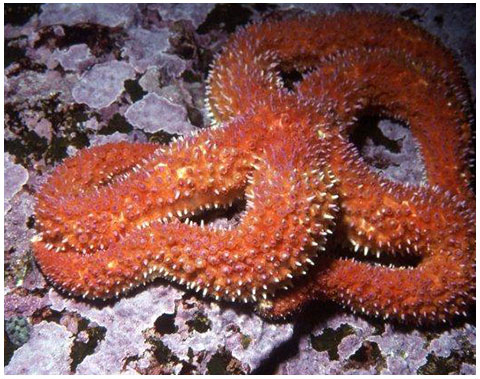





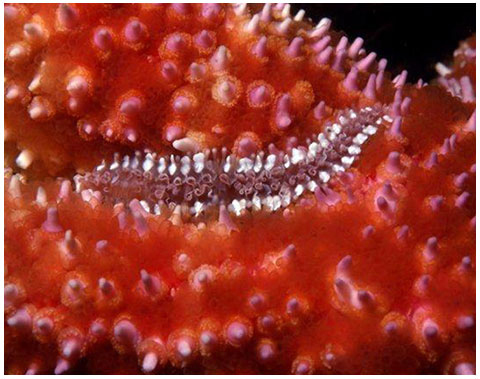

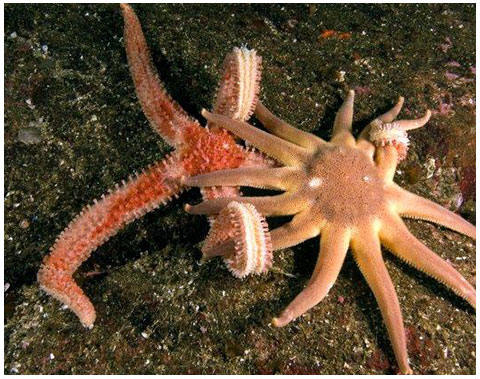

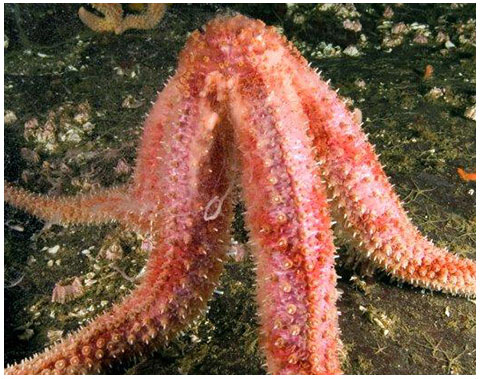
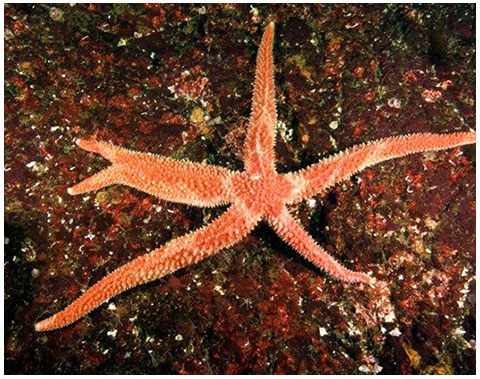
A typical, very colourful specimen. Note the characteristic long, spiny arms and small central disc.
This specimen from Quatsino Sound, on the west coast of Vancouver Island, has both purple and white spines.
A close-up view of the disc. Note the madreporite to the left, the numerous large spines surrounded by wreaths of pincers and the tufts of gills hidden between the spines.
This specimen is regenerating two of its rays.
This specimen has suffered significant damage, but is successfully regenerating new arms from the remaining intact disc and single arm.
The typical posture of a feeding specimen, humped up over its prey.
KENNERLEY'S VENUS is a favourite food. The clam is slowly defeated by the inexorable pull of the tube-feet and digestive juices of the cardiac stomach.
This star often hosts the FRAGILE RUFFLED SCALEWORM Arctonoe fragilis. Note the cryptic colour of this commensal worm.
A very young specimen only 5 cm (2 in) across. Note the pale colour compared to mature specimens.
When a RAINBOW STAR is attacked by a MORNING SUN STAR it fights back, wrapping its long and pincer-laden arms around the attacker. Note how the wreaths of pincers have expanded to the ends of the spines. After a five-minute battle, this RAINBOW STAR escaped.
RAINBOW STARS often wrap their arms around themselves. We don't know why.
This female RAINBOW STAR is spawning (look for the streams of tiny eggs). Normally they spawn from June to August, but this single specimen was observed in late November in Sechelt Inlet. Interestingly, none of the RAINBOW STARS nearby had joined in.
This RAINBOW STAR found in Sechelt Inlet had a very peculiar "split" arm.
8 - 13
Previous
NEXT
Notes:
On soft bottoms, specializes in eating the thick-shelled clam KENNERLEY'S VENUS Humilaria kennerleyi. On rocky bottoms it eats green false-jingles, tunicates, lampshells and chitons.
INTRODUCTION | ABOUT SEA STARS | BIOLOGY | SPECIES | PREDATORS / PREY | SEA STAR WASTING DISEASE | ACKNOWLEDGEMENTS | FIELD GUIDE | VIDEO
Copyright © 2018 All rights reserved.